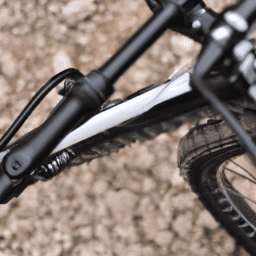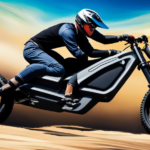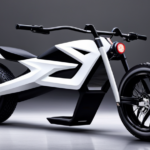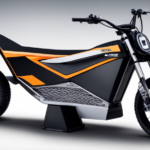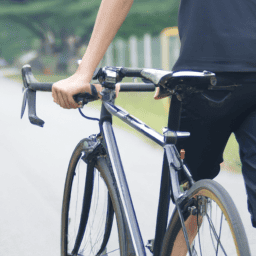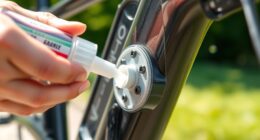I’ve had a passion for dirt biking for many years, and I must say, there’s something uniquely thrilling about tearing up the trails on a robust dirt bike.
But what exactly is a dirt bike, and why are they so popular?
In this article, I’ll provide a technical definition of a dirt bike, explore the various types of dirt biking, and offer some safety tips for those who are new to the sport.
At its core, a dirt bike is simply a lightweight motorcycle designed for off-road use.
Unlike traditional street bikes, dirt bikes feature knobby tires, long suspension travel, and a high ground clearance that enables them to navigate rough terrain.
The engines on dirt bikes are also tuned for high performance, giving riders the power they need to tackle steep inclines and rough terrain.
Whether you’re a seasoned rider or a newcomer to the sport, it’s important to understand the different types of dirt biking and choose the right bike for your needs.
Key Takeaways
- A dirt bike is a lightweight motorcycle designed for off-road use with features such as knobby tires, high ground clearance, and long suspension travel, and engines tuned for high performance.
- Different types of dirt biking include motocross, enduro, trials, and supermoto, and competitions are held worldwide, including Motocross of Nations and AMA Supercross Championship.
- Choosing the right dirt bike involves considering size, budget, riding style, and skill level, and maintenance and inspection are crucial for optimal performance and longevity.
- Safety precautions such as wearing proper protective gear, receiving proper training, and following safety guidelines are important, and there are many trails and parks available for adventure.
Definition of a Dirt Bike
A dirt bike is a two-wheeled off-road vehicle that’s designed for racing and adventurous riding. It’s also known as a motocross bike or an enduro bike.
The history of dirt biking dates back to the early 1900s, when motorcycles were first used for off-road racing. Over the years, these bikes have evolved and become more specialized, with features like high-performance engines, suspension systems, and lightweight frames.
As the sport of dirt biking grew in popularity, different types of dirt biking emerged. These include motocross, enduro, trials, and supermoto. Each type of dirt biking has its own unique set of challenges and requires different skills.
Understanding these differences is important for anyone who wants to get involved in the sport of dirt biking.
Types of Dirt Biking
You’ll love the various styles of shredding on a dirt bike, from motocross to enduro and supercross. Each type of dirt biking has its own unique set of challenges and competitions. Motocross is the most popular type of dirt biking and involves racing on a closed circuit track with jumps, turns, and obstacles. It requires a combination of speed, skill, and stamina. Enduro involves racing through natural terrain, such as forests and mountains, and requires endurance and technical riding skills. Supercross is similar to motocross but takes place in a stadium with a smaller track and more technical jumps and turns.
To give you a better idea of the differences between these types of dirt biking, here is a table outlining some of the key characteristics of each:
| Type of Dirt Biking | Track Type | Terrain | Famous Riders |
|---|---|---|---|
| Motocross | Closed Circuit | Man-Made | Ricky Carmichael, Ryan Dungey |
| Enduro | Natural Terrain | Forests, Mountains | Taddy Blazusiak, Graham Jarvis |
| Supercross | Stadium | Man-Made | Jeremy McGrath, Chad Reed |
Dirt bike competitions are held worldwide, with the most prestigious being the Motocross of Nations and the AMA Supercross Championship. Famous dirt bike riders have become household names, such as Ricky Carmichael, who has won 15 championships, and Jeremy McGrath, who has won 7 championships. However, it’s important to remember that these sports can also be dangerous if proper safety precautions are not followed.
Safety Precautions
As a seasoned dirt biker, I know that safety precautions are of utmost importance when engaging in this thrilling sport. Essential measures to take include wearing proper protective gear such as helmets, goggles, gloves, boots, and body armor to ensure maximum protection in case of a fall.
Additionally, it’s crucial to receive proper training on how to ride a dirt bike and handle various terrain conditions. It’s also important to regularly maintain and inspect your bike to prevent malfunctions and accidents.
Protective Gear
Wearing protective gear, such as a helmet and gloves, is essential when riding a dirt bike. Not only does it protect you from injuries, but it also improves your overall riding experience.
Here are four essential pieces of protective gear every dirt bike rider should wear:
-
Helmet: Choosing the right helmet is crucial. It should fit snugly and comfortably, covering your entire head and chin. Look for a helmet that’s certified by the Department of Transportation (DOT) or Snell Memorial Foundation.
-
Riding boots: Proper riding boots provide support and protection for your feet and ankles. They should fit snugly and have a sturdy sole to prevent slipping. Look for boots with sufficient ankle support and a steel toe for added protection.
-
Gloves: Gloves protect your hands from blisters, cuts, and other injuries. They should fit snugly and provide a good grip on the handlebars. Look for gloves made of durable materials, such as leather or Kevlar.
-
Goggles: Goggles protect your eyes from dust, dirt, and debris. They should fit snugly and provide clear vision. Look for goggles with anti-fog and scratch-resistant lenses.
Proper training is also essential when riding a dirt bike. It’s important to know how to properly operate the bike and navigate different terrains. With the right gear and proper training, you can enjoy the thrill of dirt biking while minimizing the risks of injury.
Proper Training
To become a skilled dirt bike rider, it’s important to seek proper training and instruction from experienced riders or certified instructors. Riding a dirt bike requires proper balance, control, and technique, and it’s crucial to learn the right skills to avoid accidents and injuries.
One way to start is by using simulation software to practice basic riding skills and maneuvers in a safe and controlled environment. This can help you get a feel for the bike’s responsiveness, weight distribution, and handling, which can be useful when you’re out on the dirt.
Another way to improve your skills is by practicing on designated tracks or trails that are suitable for your level of experience. By riding on these tracks, you can learn how to navigate different terrain, such as hills, jumps, and turns, and get a sense of how your bike performs under different conditions. It’s important to start with easy tracks and gradually increase the difficulty as you become more confident and skilled.
Remember to always wear your protective gear and ride within your limits to stay safe. With proper training and practice, you can become a confident and skilled dirt bike rider.
Speaking of safety, another important aspect of riding a dirt bike is maintenance and inspection.
Maintenance and Inspection
Regular maintenance and inspection of your dirt bike is crucial for ensuring its optimal performance and longevity. Here are some tips to help you keep your dirt bike in tip-top shape:
-
After each ride, make sure to clean your bike thoroughly to remove any dirt, mud, or debris that may have accumulated. Use a mild soap and water to clean the frame, wheels, and other components. Avoid using high-pressure washers, as they can damage sensitive parts such as the bearings and seals.
-
Regularly check the oil level and replace it as needed. Keep an eye out for any leaks, strange noises, or smoke coming from the exhaust, as these may indicate engine problems. If you notice any issues, take your bike to a mechanic for a thorough inspection.
By following these maintenance tips, you can ensure that your dirt bike runs smoothly and lasts for many years to come.
Now, let’s move on to the next section and learn about choosing the right dirt bike for your needs.
Choosing the Right Dirt Bike
Before you hit the dirt, you’ll want to make sure you’ve chosen the right dirt bike for your skill level and riding style. It’s important to consider size when choosing a dirt bike. A bike that is too big or too small can make it difficult to control and maneuver on the trails.
A good rule of thumb is to sit on the bike with both feet flat on the ground and make sure you can reach the handlebars comfortably. Additionally, consider your budget constraints when selecting a dirt bike. There are many options available, ranging from affordable beginner bikes to high-end racing bikes.
When choosing a dirt bike, it’s important to do your research and find the right fit for you. Consider your riding style and preferences, as well as your skill level and experience. Once you have found the right bike, you’ll be ready to hit the trails and put your skills to the test.
In the next section, we’ll explore where to go dirt biking and find some great locations to explore.
Where to Go Dirt Biking
Finding the perfect place to hit the trails on your dirt bike can be a challenge, but with a little research and exploration, you can discover some amazing locations to satisfy your thirst for adventure. There are many dirt bike trails and parks to choose from, each offering its own unique terrain and challenges. Some trails are designed for beginners, while others are more advanced and require a higher skill level.
When looking for dirt bike trails, it is important to do your research and find one that suits your level of expertise. Some popular dirt bike trails include the Hatfield-McCoy Trails in West Virginia, the Moab Trails in Utah, and the Glamis Sand Dunes in California. If you prefer riding in a more controlled environment, there are also many dirt bike parks that offer a variety of trails and obstacles for riders of all levels. Some popular dirt bike parks include the Southwick MX Park in Massachusetts, the RedBud MX in Michigan, and the Milestone MX Park in California. Whatever your preference, there is sure to be a dirt bike trail or park that will provide you with an exhilarating ride.
| Trail/Park Name | Location | Skill Level | Terrain | Features |
|---|---|---|---|---|
| Hatfield-McCoy Trails | West Virginia | Beginner to Advanced | Rocky, Mountainous | Scenic Views |
| Moab Trails | Utah | Intermediate to Advanced | Sandstone, Rocky | Arches National Park |
| Glamis Sand Dunes | California | Advanced | Sand Dunes | Open Terrain |
| Southwick MX Park | Massachusetts | Beginner to Advanced | Muddy, Wooded | Motocross Track |
| RedBud MX | Michigan | Intermediate to Advanced | Sandy, Loamy | Motocross Track |
| Milestone MX Park | California | Beginner to Advanced | Sandy, Loamy | Motocross Track, Jump Lines |
Frequently Asked Questions
How much does a dirt bike cost on average?
A dirt bike can cost anywhere from $3,000 to $10,000 depending on the make and model. Customization options and financing options are available to fit your budget and needs. It’s important to do your research before making a purchase.
What are the different engine sizes available for dirt bikes?
When it comes to dirt bike engine sizes, there are a few options to consider. Smaller engines, like a 125cc, are great for beginners or younger riders, while larger engines, like a 450cc, provide more power for experienced riders. Choosing the right engine size for your needs depends on your skill level and the type of riding you plan on doing. Pros and cons should be weighed carefully before making a decision.
What gear should I wear while dirt biking?
I’m not sure what a dirt bike is, but I do know that when I ride one, I always make sure to wear a helmet for safety and protective clothing to protect myself from any potential injuries. It’s important to take safety seriously when dirt biking.
Can I ride a dirt bike on public roads?
No, it is generally illegal to ride a dirt bike on public roads. Legal restrictions vary by location, but safety measures should always be taken when riding off-road, including wearing proper gear and following trail guidelines.
How often should I maintain my dirt bike?
As a dirt bike owner, I prioritize regular maintenance to ensure optimal performance and longevity. I follow the adage ‘prevention is better than cure’ and keep up with routine oil changes, air filter replacements, chain maintenance, and tire pressure checks.
Conclusion
In conclusion, a dirt bike is a type of motorcycle designed for off-road use. They’re typically lightweight, with knobby tires, and have suspension systems that can handle rough terrain. Dirt biking is a popular sport and recreational activity that allows riders to experience the thrill of riding on unpaved surfaces and performing stunts.
When it comes to safety, wearing proper protective gear such as helmets, goggles, and boots is essential. It’s also important to ride at a safe speed and to be aware of your surroundings. Choosing the right dirt bike is crucial to ensure a safe and enjoyable experience. Factors to consider include the rider’s skill level, height, and weight.
Did you know that dirt biking is a growing sport? According to a report by Allied Market Research, the global dirt bike market is expected to reach $446.5 million by 2026, with a compound annual growth rate of 4.6%.
This just goes to show that more and more people are discovering the excitement and adventure of dirt biking. Whether you’re a beginner or an experienced rider, taking the necessary precautions and choosing the right equipment can help ensure a fun and safe ride.
